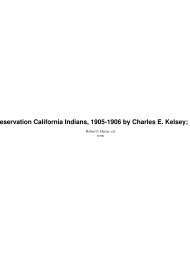“Parkitecture†68(2):3-5 by Charles Palmer - Yosemite Online
“Parkitecture†68(2):3-5 by Charles Palmer - Yosemite Online
“Parkitecture†68(2):3-5 by Charles Palmer - Yosemite Online
You also want an ePaper? Increase the reach of your titles
YUMPU automatically turns print PDFs into web optimized ePapers that Google loves.
PHOTO COURTESY OF THE AUTHOR.<br />
a reputation as the designer of New York’s Central Park<br />
and had demonstrated remarkable organizing powers<br />
with the Sanitary Commission and the War Department.<br />
In San Francisco, Olmsted developed a plan in the 1860s<br />
(influential, although never implemented) for presentday<br />
Golden Gate Park, and in Oakland he designed<br />
Mountain View Cemetery (dedicated May 1865) with<br />
curvilinear roads contoured to the land. This cemetery<br />
adjoins Piedmont at a location about four blocks from<br />
Joseph Worcester’s 1876 Piedmont house, and from its<br />
heights there is a magnificent view over the entire bay. In<br />
addition, on March 7, 1865, Olmsted was officially commissioned<br />
<strong>by</strong> the Trustees of the University of Ca1ifornia<br />
to develop a plan for a new college campus in what later<br />
became the city of Berkeley.<br />
Hutchings Hotel in <strong>Yosemite</strong> Valley, photographed <strong>by</strong> J. J. Reilly after 1864.<br />
I boarded with Mr. Hutchings’ family, but occupied a<br />
cabin that I built for myself near the Hutchings’ winter<br />
home. This cabin, I think, was the handsomest building<br />
in the Valley, and the most useful and convenient for a<br />
mountaineer. From the <strong>Yosemite</strong> Creek near where it first<br />
gathers its beaten waters at the foot of the fall, I dug a<br />
small ditch and brought a stream into the cabin, entering<br />
at one end and flowing out the other with just current<br />
enough to allow it to sing and warble in low, sweet<br />
tones, delightful at night while I lay in bed. The floor was<br />
made of rough slabs, nicely joined and embedded in the<br />
ground. In the spring, the common pteris ferns pushed<br />
up between the joints of the slabs, two of which, growing<br />
slender like climbing ferns on account of the subdued<br />
light, I trained on threads up the sides<br />
and over my window in front of my<br />
writing desk in an ornamental arch.<br />
Dainty little tree frogs occasionally<br />
climbed the ferns and made fine music<br />
in the night, and common frogs came<br />
in with the stream and helped to sing<br />
with the hylas [tree toads] and the<br />
warbling, tinkling water. My bed was<br />
suspended from the rafters and lined<br />
with libocedrus plumes, altogether<br />
forming a delightful home in the<br />
glorious valley at a cost of only three or<br />
four dollars, and I was loathe to leave it.<br />
We can imagine Worcester, then a young man of<br />
twenty-seven compared with the older Olmsted at fortytwo<br />
and Muir at thirty, transformed <strong>by</strong> the raw vitality<br />
of his experiences in frontier California, impressed <strong>by</strong><br />
<strong>Yosemite</strong>’s majesty, and challenged <strong>by</strong> his meetings with<br />
Olmsted and Muir; after all, something convinced him<br />
to give up Boston and escape the traditional East Coast<br />
milieu, ignoring his family’s strong opposition.<br />
Olmsted and Muir’s California work had a huge<br />
influence on the San Francisco Bay Region as did<br />
Worcester’s ideas ten to fifteen years later. If not Olmsted<br />
and/or Muir, something turned Joseph Worcester<br />
from a shy and reserved young man into another<br />
man—a more sophisticated, self-confident individual,<br />
convinced of his opinions and confident in his ability<br />
to influence others toward what he saw as best.<br />
Muir and Worcester, like Olmsted, shared a reverence<br />
for nature and determined to live in houses reflecting that<br />
quality. Muir’s description of his <strong>Yosemite</strong> “hangnest”<br />
reveals that, though a simple structure, it was designed<br />
specifically to bring nature into his home:<br />
Whether or not they met in<br />
<strong>Yosemite</strong>, it is clear Worcester shared Olmsted’s and<br />
Muir’s commitment to buildings that were designed to<br />
enhance and encompass the natural world.<br />
This article was excerpted from Building with Nature:<br />
Inspiration for the Arts & Crafts Home reprinted with<br />
permission. Copyright 2005 <strong>by</strong> Leslie M. Freudenheim;<br />
Gibbs Smith, Publisher, PO Box 667, Layton, UT 84041.<br />
To purchase this book, see page 30.<br />
Leslie Freudenheim is an authority on architectural<br />
history, and has been published in the Baltimore Sun<br />
and the Washington Post. She served as editor of<br />
Federal Design Matters for the Design Department,<br />
National Endowment for the Arts. Since 2002 she has<br />
been studying Arts & Crafts homes and the architectural<br />
and social roots of this movement.<br />
8 YOSEMITE ASSOCIATION, SPRING 2006




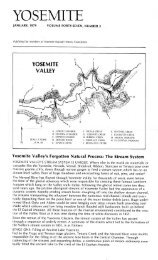
![(March 1982) [PDF] “We Are Pleased to Announce†- Yosemite Online](https://img.yumpu.com/51299748/1/190x242/march-1982-pdf-aeuroewe-are-pleased-to-announceaeur-yosemite-online.jpg?quality=85)
![[PDF] Old Horny, Yosemite's Unicorn Buck - Yosemite Online](https://img.yumpu.com/51269869/1/184x260/pdf-old-horny-yosemites-unicorn-buck-yosemite-online.jpg?quality=85)
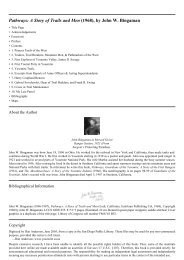
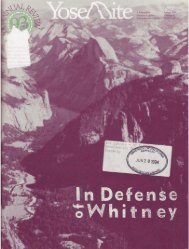
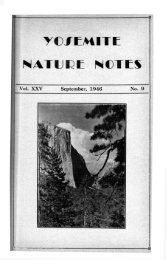
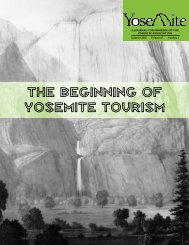
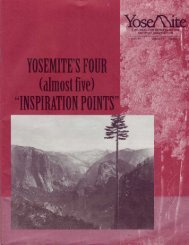
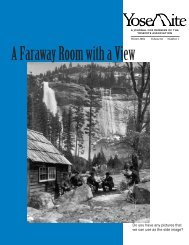
![1985 [PDF] - Yosemite](https://img.yumpu.com/48128837/1/184x260/1985-pdf-yosemite.jpg?quality=85)

